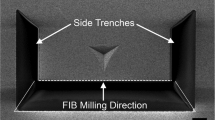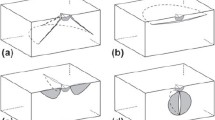Abstract
The fracture toughness of small volumes of brittle materials may be investigated by using pyramidal indenters to initiate radial cracks. The length of these cracks, together with indenting load and the hardness to modulus ratio of the material, were combined to calculate the critical stress intensity factor Kc pertinent to fracture toughness. Modulus and hardness may be obtained from the literature or may be measured using nanoindentation techniques. If the material volume is very small, such as single grains in a conglomerate, a reduction of scale may be obtained by reducing the internal face angles of the indenter. This encourages crack initiation at lower loads, but cracks produced at very low loads are short and difficult to measure. Experiments on fused silica and glassy carbon suggested that radial cracks are initiated during loading and that when indenters with sufficiently small angles are used these cracks immediately pop-in, to become fully developed median/radial crack systems. Following pop-in, the rate of penetration of the indenter increases and at higher loads there is an extra increment of penetration over that which would otherwise have occurred. In this study a method is described whereby this extra penetration may be determined. Then for two dissimilar brittle materials, crack length is shown to be correlated with extra penetration leading to a relationship that may possibly avoid the necessity for crack-length measurement.
Similar content being viewed by others
References
B.R. Lawn, A.G. Evans, and J. Marshall, J. Am. Ceram. Soc. 63, 574 (1980).
D.S. Harding, W.C. Oliver, and G.M. Pharr, in Evolution of Thin-Film and Surface Structure and Morphology, edited by B.G. Demczyk, E.D. Williams, E. Garfunkel, B.M. Clemens, and J.J. Cuomo (Mater. Res. Soc. Proc. 355, Pittsburgh, PA, 1995), p. 663; see also G.M. Pharr, Mater. Sci. Eng. A 253, 151 (1998).
W.C. Oliver and G.M. Pharr, J. Mater. Res. 7, 1564 (1992).
D.J. Rowcliffe, Key Eng. Mater. 71, 10 (1992).
R.D. Dukino and M.V. Swain, J. Am. Ceram. Soc. 75, 3299 (1992).
F. Ouchterlony, Eng. Fract. Mech. 8, 447 (1976).
S.S. Chiang, D.B. Marshall, and A.G. Evans, J. Appl. Phys. 53, 298 (1982).
R. Hill, The Mathematical Theory of Plasticity (Clarendon, Oxford, U.K., 1950).
K. Johnson, J. Mech. Phys. Solids 18, 115 (1970).
E.H. Yoffe, Philos. Mag. A 46, 617 (1982).
S. Palmquist, Jemkontorets Ann. 141, 300 (1957).
R.F. Cook and G.M. Pharr, J. Am. Ceram. Soc. 73, 787 (1990).
H. Tada, P. Paris, and G. Irwin, The Stress Analysis of Cracks Handbook (Del Research, St. Louis, MO, p. 24.9).
N. Iwashita, J.S. Field, M.V. Swain, N. Ohta, and S. Bitoh, Carbon 39, 1525 (2001).
P.J.F. Harris, in The Encyclopedia of Materials: Science and Technology (Elsevier, Amsterdam, The Netherlands, 2001).
J.S. Field and M.V. Swain, Carbon 34, 1357 (1996).
M.V. Swain and J.S. Field, Philos. Mag. A 74, 1085 (1966).
D. Munz and T. Fett, The Chemical Properties of Ceramic Materials (Springer Verlag, Berlin, Germany, 1989).
N. Iwashita (private communication, 2000).
Author information
Authors and Affiliations
Rights and permissions
About this article
Cite this article
Field, J.S., Swain, M.V. & Dukino, R.D. Determination of fracture toughness from the extra penetration produced by indentation-induced pop-in. Journal of Materials Research 18, 1412–1419 (2003). https://doi.org/10.1557/JMR.2003.0194
Received:
Accepted:
Published:
Issue Date:
DOI: https://doi.org/10.1557/JMR.2003.0194




